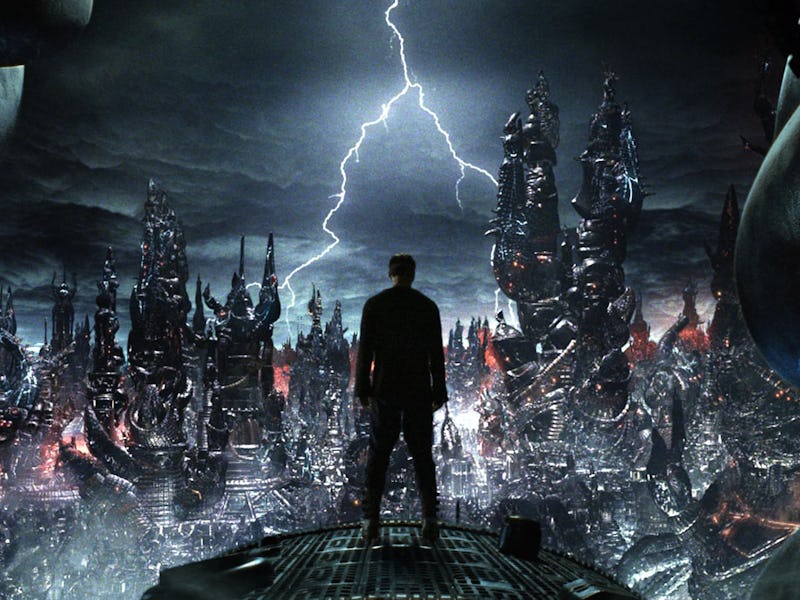You need to watch the most stunning sci-fi trilogy ending on HBO Max ASAP
It's time to catch up with an underrated entry in this iconic '00s sci-fi franchise.

Endings are hard.
When it comes to big-screen trilogies, third entries can prove tricky to execute. The third Godfather movie is considered a weaker outing for that seminal franchise, Spider-Man 3 is an overwrought step down from its predecessors, Blade: Trinity is highly forgettable, and so on.
Carrying the weight of two previous movies while offering a conclusion for their overarching story is a tall order that can often drag a film down.
In ending their Matrix franchise, the Wachowskis aimed to keep their highly anticipated trilogy topper out of this category. They didn’t quite manage that, as the 2003 threequel they came up with undoubtedly drags at times. But here’s why The Matrix Revolutions is still worth adding to your watchlist, especially ahead of The Matrix Resurrections hitting screens later this year.
A more charitable reading of The Matrix Revolutions is that its filmmakers threw everything they could think of into the story, sometimes with less-than-cohesive results. But to their credit, a great deal of it works.
As the directors of two back-to-back Hollywood megahits, the Wachowskis were also well-known in 2003 for their aversion to publicity. Wired described their sets as having a “button-downed” professional atmosphere, and there was little visibility of both the directors themselves and the overall direction of their franchise.
By 2003, The Matrix had become firmly enmeshed in popular culture, and its aesthetic reflected a specific held-over ’90s sensibility: leather, sunglasses, and the infamous “bullet time” visuals.
When Reloaded hit theaters, it was the biggest movie of the summer. The Matrix had by that point spiraled into multiple properties — including The Animatrix, a widely praised anime anthology, and Enter the Matrix, a video game that sold over 5 million copies. Though some critics, including A.O Scott in the New York Times, denounced Reloaded as an overly ponderous “summer-reading-list blockbuster,” audiences still seemed enthusiastic.
Keanu Reeves in The Matrix Revolutions.
Bringing it all home in November would be Revolutions. Warner Bros., seeking to “event-ize” the movie and stave off pirates, announced a first-ever global theatrical debut. Simultaneously, theaters would screen the finale in this epic battle between humanity and machines. It was a fitting moment of unity for the franchise.
While Reloaded suffered at its beginning and end, Revolutions excels in those areas. Neo (Keanu Reeves) is effectively removed from the rest of the humans, stuck in a world between the machines and the human Zion. He meets a charming Indian family, including daughter Sati (Tanveer K. Atwal). To Neo’s surprise, this is a family of Matrix programs, who are hoping to save their daughter’s life, as they created her with no purpose save for love.
Each program embodies some element of humanity. The Oracle (played by Mary Alice, after the passing of Gloria Foster) represents kindness; her bodyguard Seraph (Collin Chou) represents honor; the Architect (Helmut Bakaitis) represents arrogance; and the Merovingian (Lambert Wilson) represents debauchery. Agent Smith (Hugo Weaving), meanwhile, represents sheer hatred.
Laurence Fishburne, Keanu Reeves, and Carrie-Anne Moss in The Matrix Revolutions.
Compared to the programs, the actual humans in Revolutions are mostly a drag. The few points of intrigue between them — like a love triangle between Morpheus, Commander Locke, and Niobe (Laurence Fishburne, Harry Lennix, and Jada Pinkett Smith) — are forgotten. Characters like The Kid (Clayton Watson), supposed to offer a ground-level view of the city, mainly bring things from one place to another for interchangeable military commanders.
The only humans who show any real passion in Revolutions are Neo (Keanu Reeves) and Trinity (Carrie-Anne Moss), who can bring some intimacy on the voyage to Machine City.
Most of the movie is spent preparing for the machine assault on Zion, and this scene does pay off. David Denby, in a primarily negative review for The New Yorker, granted that whatever the Wachowskis’ flaws, they could “make a two-hour movie that remains visually interesting, even eccentric, without a trace of natural light.” The squid-like sentinels flock like murderous birds, and the gun-mechs of the human army fight bravely while being chopped down.
But people did not swarm theaters to see the robots. They came to see kung-fu. And martial arts, which the Wachowskis facilitate so nimbly in the first two films, is mostly absent in Revolutions, save for the climactic scene between Neo and Smith.
A scene from The Matrix Revolutions.
Their battle is the trilogy’s most enduring, with philosophical stakes that the more significant conflict lacks. Neo represents the human capacity to choose, while Smith creates a world of sneering doubles. The grand finale goes full wuxia, with the two fighting mid-air in the rain as an army of Smith clones look on. As far as pivotal battles go, Neo vs. Smith delivers on everything the trilogy wanted to express.
After that conflict, the film closes with scenes of programs in a park. These aren’t the characters we have been rooting for, although they are the more interesting ones. Together, they enjoy a technicolor sunset while the fate of humanity is barely mentioned.
It’s a final swerve from a trilogy filled with them, suggesting the real ending can be found somewhere else. Whether it’s earlier in the movie, as a blinded Neo heals the rift between man and machine, or even in the upcoming Matrix Resurrections is anyone’s guess.
The Matrix Revolutions is now streaming on HBO Max.